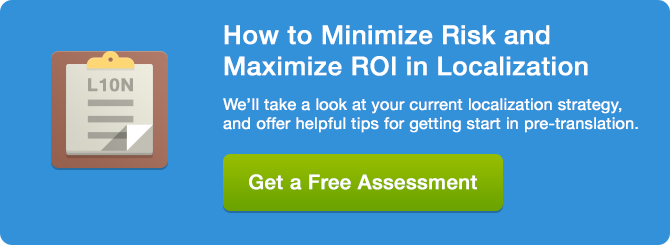Localization PMs: 10 Ways It Can Help Translators

Nowadays context is king, especially if we talk about localization of apps, software, games, websites and web services. The more context translator has, the more accurate translation will be. Often translator has to work with source strings extracted in the CAT-tool only with no or little context. Fortunately, more and more localization PMs and product managers, that are responsible for translation and localization, understand the importance of context. So in what ways can they provide more contexts and give a hand of help to their translators and editors? Let’s name a few.
1. Comments and screenshots
Of course, comments that can display in translation environment and screenshots of new functionality can clear the situation. Often (in the case of games translation, for example) screenshots are provided in Excel sheet alongside with source phrases and sentences.
2. Providing a feedback loop
It’s good to have some kinds of Q&A forms or communication system (for example, online shared spreadsheet, build-in form or shared database) so translators can share their concerns there and receive answers from copywriters, localization PMs, developers and product managers quickly. In this way, the feedback can be implemented before the translation is sent back to the client.
3. Introducing variables (gender, plural)
Sometimes copywriters and developers don’t take into account that, unlike English which is an “analytic” language where sentence meaning is defined by syntax (i.e. words order), many languages, like Russian, Ukrainian, are “flective” languages where meaning of sentence is defined by changing words (morphology). Therefore, you must pay attention to stuffs like suffixes and prefixes. So introduction of gender and plural variables is very important to get natural flawless translation.
There are many tools and methods that can help programmers with that. For example, the ICU Syntax allows to translate phrases into multiple languages while taking account of linguistically appropriate changes for gender and number. The exact rules of using which numbers or forms depend on the language in use. See the language plural rules page on the Unicode site for the full list of languages and their plural forms.
4. Naming of files that provides context
Naming of resource files logically, for example, “profile_page”, “settings”, “payment_info” can give translators additional contexts. Besides, developers or copywriters can indicate in the resource file name if that is a desktop or mobile application, so translators can allow longer translation or shorter one appropriately.
5. Naming of other resources
Above principle also applies to naming of other resources. In the resource ID or message ID, project owners can indicate additional information telling translators where certain string will be displayed. This is especially helpful if there are similar phrases, like “Ask” buttons, that are displayed in a few different places and can be translated differently (as verb and noun). Using unique string ID, PMs can indicate where those phrases belong.
6. Reference materials
Reference materials, such as glossaries, style guides, and brand guidelines, can provide translators helpful information like preferred translations of terms, tone of voice, description of product and its features…etc. To fully take advantage of these benefits, PMs have to ensure the reference materials are current and updated regularly.
7. Localization and internationalization trainings, product trainings, style trainings
Ideally, these different trainings can be provided by the leading linguist, localization PM, product manager or developers. During those trainings, translators can get more in depth knowledge of localization and internationalization processes and peculiarities (for example, formats of gender and plural forms). They can also communicate interactively with editors to work on mistakes and improve general knowledge of the product and tone of voice.
8. In-context translation and “diving” into the context
Most of the time, translators have to work with anonymous strings in a translation tool without looking at the actual product, which increases the chance of contextual errors. Luckily, there are WYSIWYG (what you see is what you get) translation tool, plug-ins and modules that allow translators to do their works on actual live web pages now. In this way, translators will know immediately if their translations break the site’s design, saving much time during the quality assurance process.
9. Linguistic and localization testing
One of the main stages of localization is linguistic and localization testings that are often performed in-house or allocated to external resources. It can be done in a form of live product review or, for example, parallel screenshots review.
While localization testing focuses to verify correct functionality, appearance and completeness of the localized product, the main goal of linguistic testing is to ensure the correct language rules are being used. Linguistic testing helps to find linguistic errors in spelling, grammar, and punctuation.
During localization testing, one can find inconsistent terminology, cosmetic errors, such as wrong text justification, stacking of elements, cutting off the text…etc. Also, the functionality of product is verified and errors in text adoption can be located. For example, a part of text is not displayed, the selected font is not supported, original text is displayed instead of translation or the wrong language is displayed…etc.
Oftentimes manual localization testing can be replaced by automated localization testing that is run by scripts and it’s a more efficient method when a product is localized into many languages.
10. Editor’s feedback
Efficient cooperation with editors and reviewers is very important to preserve the high quality of translation. Editors can provide their feedback in the form of weekly/monthly/quarterly feedbacks and error analysis, comments to projects, immediate reaction to obvious mistakes or trainings…etc.
Of course, taking steps mentioned above requires much time and efforts from localization PMs, product managers or project owners but it’s a good investment that will definitely pay off in long run. High quality of translation is a common goal for localization projects managers, translators, editors, testers, developers, copywriters so thorough localization and internationalization planning and implementation is vital if you want to expand your product into new markets and achieve great success.
Image source: HubSpot



 Written by -
Written by - 




 Written by
Written by 



1 Response
[…] quotes? It’s really quite simple. Articles and posts on finance for freelance translators Localization PMs: 10 Ways It Can Help Translators Best Practices for Global Internal Communications The Twelve Stages to Learning a Foreign Language […]